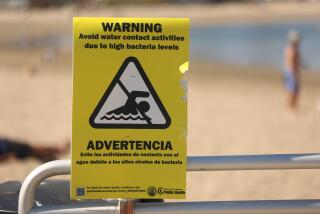Policy on Closing of Beaches Drafted
- Share via
Los Angeles County officials have drafted an unprecedented policy to increase public awareness of potential health risks of swimming in the ocean after heavy rains, sewage spills and environmental accidents.
A beach regulatory protocol to be considered by the County Board of Supervisors today would be the first of its kind in California, said officials from the state Department of Health Services.
The policy has been negotiated over the last four months by environmentalists and county officials, at the request of supervisors. It gained increased urgency during the past week, when a massive sewage spill fouled San Diego beaches and the heaviest rains of the season washed a witches’ brew of urban waste into Santa Monica Bay.
“This is especially timely right now,” said Supervisor Ed Edelman, who four months ago demanded the review of the county’s policies. “Look what is happening in San Diego right now. People might not like having the beaches closed, but we have to let them know there can be health risks.”
In the past, county health officials had wide discretion in closing beaches or posting signs warning the public of contamination. Environmentalists complained that officials were often too slow in alerting the public about potential dangers.
Those complaints reached a peak last March, when 21,000 gallons of diesel fuel spilled from an underwater pipeline a mile offshore from the Chevron oil refinery in El Segundo. The fuel stained 3 1/2 miles of beach in Malibu.
Officials from the American Oceans Campaign and Heal the Bay, two environmental groups, protested that county health officials were slow to warn the public about the spill and then closed only a short stretch of the contaminated beach.
The protocol would require that the public be immediately notified of spills of hazardous material. The entire stretch of polluted beach would also be closed to swimming.
The proposed guidelines would also:
* Require the county Department of Health Services to issue an advisory, telling the public to avoid contact with ocean water for 72 hours after significant rainstorms. Storms wash a nasty combination of oil, grease, pesticides, metals, lawn clippings and pet droppings down storm drains and into the ocean.
* Use ocean water samples, for the first time, as a basis for closing beaches and posting warning signs. Researchers have found high concentrations of bacteria in Santa Monica Bay for years, exceeding state standards for bathing water. But health officials have usually declined to warn the public, attributing the bacteria to plants and other organic material that are not a health threat.
* Institute specific rules for closing beaches during sewage spills. Spills of less than 1,000 gallons would force the posting of “No Swimming” signs for a quarter-mile in each direction. After a spill of 2 million gallons, beaches would be closed for 10 miles in either direction. The closures would remain in effect for at least 48 hours.
* Impose special rules for Surfrider Beach in Malibu, the scene of a long-running feud between surfers and county officials.
Surfers have complained that county workers, without warning, regularly cut a canal through the sand in an effort to prevent septic tank backups. That, the surfers say, releases contaminated water from nearby Malibu Lagoon into the ocean.
Under the plan, the beach would be closed or posted with warning signs for 48 hours after the channel is cut in order to allow the smelly, algae-laden lagoon to be flushed into the ocean.
Activists conceded that many die-hards, particularly surfers, will not let a few warning signs stand between them and good surf.
“Once the public knows, then they can make their own decision about whether to go in or not,” said Lisa Weil, policy director of the American Oceans campaign, who helped negotiate the policy. “All we want is informed consent.”
More to Read
Sign up for Essential California
The most important California stories and recommendations in your inbox every morning.
You may occasionally receive promotional content from the Los Angeles Times.














